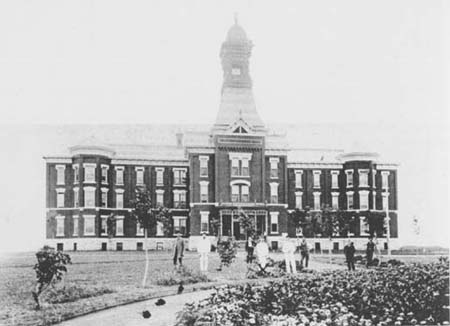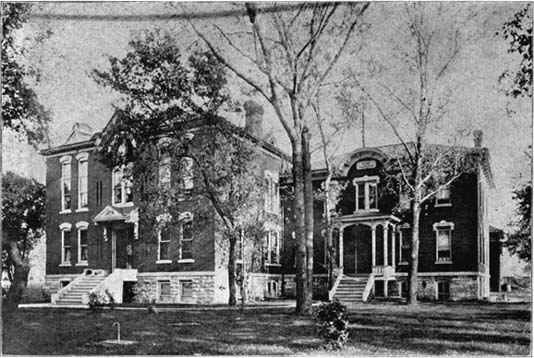Nebraska
Number
of victims
In
total, 902 individuals were sterilized in Nebraska, 53% of whom were
women. 80%
of those sterilized were deemed “mentally deficient.”
Roughly 18% of the total sterilizations were
of individuals deemed “mentally ill.”
Nebraska
ranks 14th in the United States in terms of
total number of
sterilizations.
Period
during which sterilizations
occurred
The
sterilizations began in 1917 and ended in 1963, with the last ten
sterilizations occurring during that year (Paul, p. 412).
Temporal
pattern of sterilizations
and rate of sterilization

Other
than a somewhat higher increase between 1921 and 1928, sterilizations
rose
relatively steadily until 1941, after which there was a sharp increase
until
1944. 79
sterilizations were performed
in 1943 alone—a much higher number than pre-1941 sterilizations per
year. Between 1941
and 1944, an average of 74
people were sterilized per year, making these years the peak period of
sterilizations in Nebraska. During this period, 6 persons per 100,000
Nebraska
residents were sterilized per year.
After 1944, sterilizations continued at a steady pace
until 1963, when
they ceased altogether, with the final ten sterilizations occurring in
that
year (Paul, p. 412).
Passage
of law(s)
In
Nebraska, the first law regarding sterilization was passed in 1915,
after a
failed initial attempt by state legislators in 1913 was vetoed by
Governor John
H. Morehead (Paul, p. 408). This law was revised in both 1929 and 1957
(Paul,
p. 409).
Groups
identified in the law
The
1915 law provided for the sterilizations of the insane and
feeble-minded
inmates of state institutions before they were paroled (Landman, p. 74). The state institutions
specifically mentioned
in the statute included “institutions for the feeble-minded, hospitals
for the
insane, the penitentiary, reformatory, industrial schools, the
industrial home,
and other such State institutions” (Laughlin, p. 13).
In
1929, the original law was repealed and a new law was enacted, which
included
“habitual criminals, moral degenerates, and sexual perverts“—those
individuals
convicted of rape or incest—as well as the original groups (Landman, p.
75).
The
final 1957 amendment of the 1929 law decreased the scope, permitting
the
sterilizations solely of members of the Beatrice State Home for the
"mentally
deficient." This
alteration thereby
exempted the insane and “habitually criminal.” This modification also
provides
an explanation of the high ratio of "mentally deficient" to mentally ill
sterilized, as only the former were housed in the Beatrice State home
(Paul, p.
409).
Process
of the law
The
first law, passed in 1915, stated that all inmates of state
institutions for
the feebleminded, as well as inmates of penitentiaries, were lawful
candidates
for sterilization. If these inmates were going to be
discharged, they
were made to stand in front of a panel who questioned them on their
family
history, mental and physical characteristics, etc. If they
were found to
possess undesirable genetic traits, they were offered a choice: undergo
a sterilization
procedure and be released into society, or keep their reproductive
system
intact but stay in the custody of the state (Hered). The consent of the patient or his or her family was necessary
in order to
proceed with the sterilization (Paul, p. 408).
The
1929 revision of the law made it so that any inmate convicted of rape
or other
crimes of sexual perversion were to be compulsorily sterilized. Although the sterilization
was mandatory for
these individuals, the law mandated both notice and hearing and the
potential
for appeal to the Supreme Court (Paul, p. 409).
The
final alteration of the law, in 1957, tightened the scope of the
legislation to
include only inmates of the Beatrice State Home (Paul, p. 410).
Precipitating
factors and processes
Popular
fears of a state plagued by “social incompetents” were the driving
force behind
a widespread support of sterilization legislation in Nebraska (Landman,
p.
75). The state’s
declared motive for its
sterilization laws was “purely eugenic” (Laughlin, p. 13).
Groups
targeted and victimized
Although
habitual criminals and sex offenders were included in the law between
1929 and
1957, the “feeble-minded” were the initial targets. They remained a
group of
concern for several years after the state ceased its sterilizations of
the
criminal (Paul, p. 409). The
ratio of
men to women sterilized is relatively equal, indicating no presence of
bias
toward either sex.
Other
groups targeted
In
1929, the Nebraska legislature altered the sterilization law to include
those
individuals convicted of sodomy. This
amendment included individuals who had been deemed “moral degenerates
or sexual
perverts” (Painter).
“Feeder institutions” and
institutions where
sterilizations were performed
 (Photo origin: University of Nebrasky-Lincoln, available at http://www.unl.edu/nicpp/images/BSDC1.JPG)
(Photo origin: University of Nebrasky-Lincoln, available at http://www.unl.edu/nicpp/images/BSDC1.JPG)
According
to data provided by Julius Paul, more than 80% of sterilizations
occurred on
residents of the Beatrice State Home, founded in 1887 as the Nebraska Institution for Feebleminded Youth (Laughlin, p. 74). The
institution is now known as the Beatrice
State Developmental Center, specializing in the treatment of children
and
adults with behavioral and developmental disabilities (Nebraska Dept.
of
Health). The website makes no mention of the location’s past
involvement with
eugenics and sterilization. In terms of a history, the website states,
briefly,
that the Center “has served citizens with mental retardation since
1887”
(Nebraska Dept. of Health). In
this
statement, the website makes no mention of the past monikers of the
location.
The
Norfolk Hospital for
the Insane was established in 1885 on 320 acres of land provided by the
city of
Norfolk (Adams County Historical Society).

The Hospital for the Incurably Insane was established in
1889. This institution went
through several name
changes. In 1895,
the legislature voted
to call it the Asylum for the Chronic Insane.
In 1905, the name was changed to Nebraska State Hospital,
and then again
in 1915 it was renamed the Ingelside Hospital for the Insane. It was briefly referred to
as the Hastings
State Hospital, and adopted its current name, “Hastings Regional
Center,” in
1971 (Adams County Historical Association). The Adams County Historical
Society’s website makes no mention of the sterilizations that occurred
at this
location. However,
according to
Laughlin, 32 sterilizations had occurred at this location prior to 1921
(Laughlin, p. 74). The Hastings Regional Center is currently a mental
health
and substance abuse treatment facility for adolescent and young adult
males who
have been paroled from the Youth Rehabilitation Treatment Center in
Kearney,
Nebraska (Nebraska Dept of Health).

The
Lincoln Hospital for
the Insane was established in 1870, but was only open for a brief
period when
an accidental fire forced the State to close the facilities for
renovations. It
re-opened in 1871
(Historic Asylums). According to Paul, 78 sterilizations occurred at this
location prior
to 1921 (Paul, p. 74).
Opposition
Governor
John H.
Morehead initially vetoed sterilization legislation in 1913, stating
that it
was “more in keeping with the pagan age than with the teachings of
Christianity.” The
law passed without
his support in 1915, as he did not veto it (Paul, p. 408).
Bibliography
Adams
County Historical
Society. 2006. “Hastings State Hospital.” Available at <http://www.rootsweb.ancestry.com/~asylums/hastings_nb/index.html>.
Hered, J. 1916. “Nebraska.” The
Journal of Heredity 7: 238.
Historic
Asylums.
“Lincoln Insane Asylum.” Available at
<http://www.rootsweb.ancestry.com/~asylums/lincoln_ne/index.html>.
Landman,
J. H. 1932. Human Sterilization: The History
of the Sexual Sterilization Movement.
New York: MacMillan.
Laughlin,
Harry H. 1922. Eugenical Sterilization in the
United States. Chicago: Municipal
Court of Chicago.
Nebraska
Department of Health and Human Services.
2007. "Beatrice State Developmental Center." Available at <http://www.dhhs.ne.gov/dip/ded/bsdcindex.htm>.
Nebraska
Department of Health and Human Services.
2008. “Hastings Regional Center.” Available at <http://www.hhs.state.ne.us/beh/rc/hrcserv.htm>.
Painter,
George. 1991. “Nebraska.” In The Sensibilities of Our
Fathers: The History of Sodomy Laws in the United States. Available at <http://www.glapn.org/sodomylaws/sensibilities/nebraska.htm>.
Paul,
Julius. 1965. “‘Three Generations of Imbeciles
Are Enough’: State Eugenic Sterilization Laws in American Thought and
Practice.” Unpublished manuscript. Washington, D.C.: Walter Reed Army
Institute
of Research.
Rietsch,
Pam. 2002. “Semi-Centennial History of
Nebraska, 1904.” NEGenWeb.
Available at
<http://www.usgennet.org/usa/ne/topic/resources/OLLibrary/SCHofNE/pages/contents.htm>.